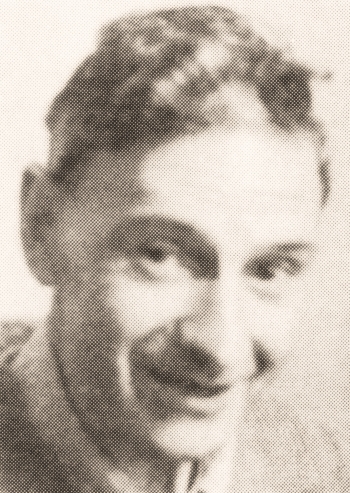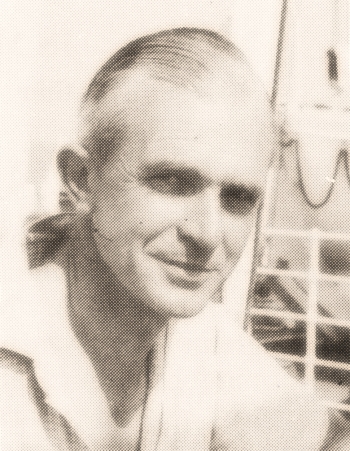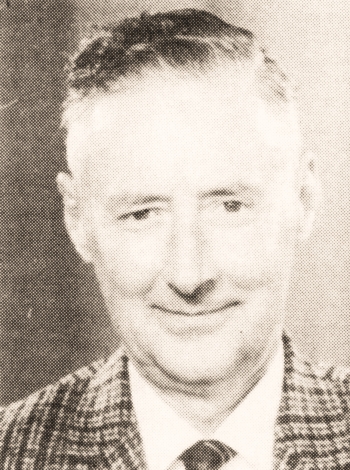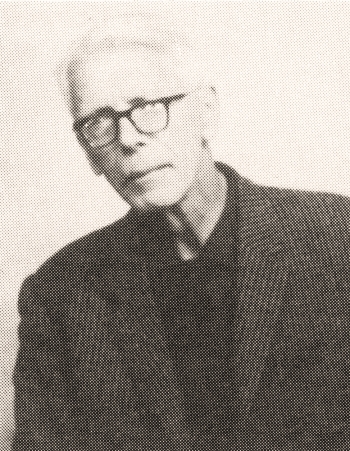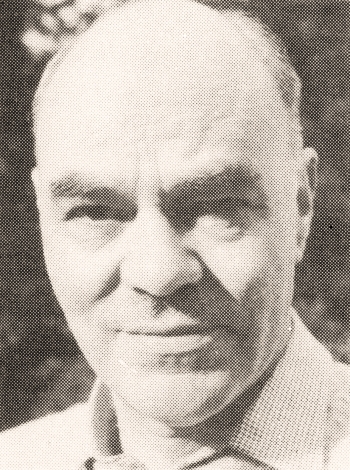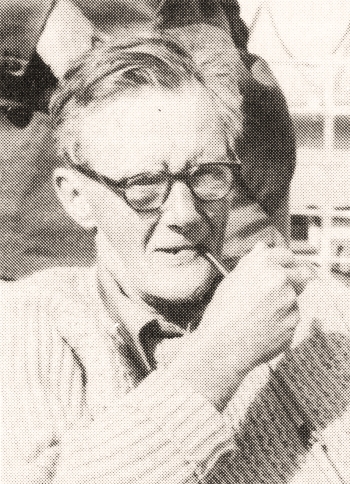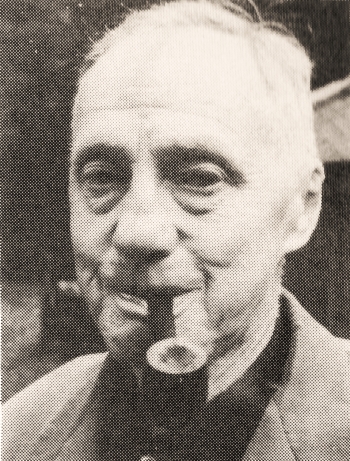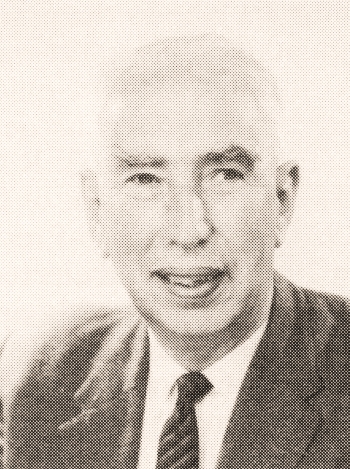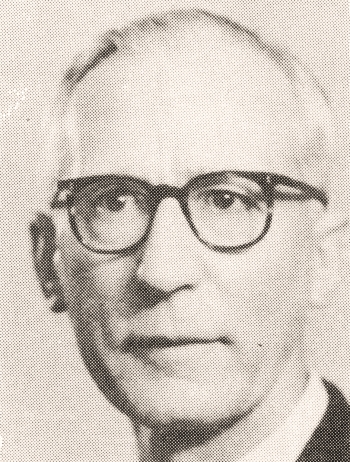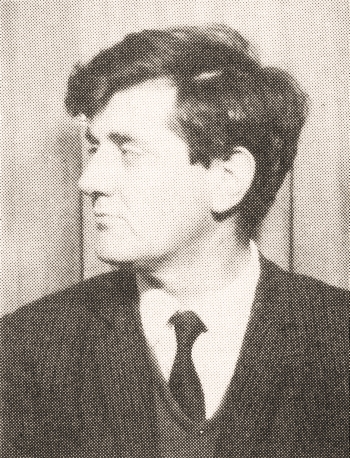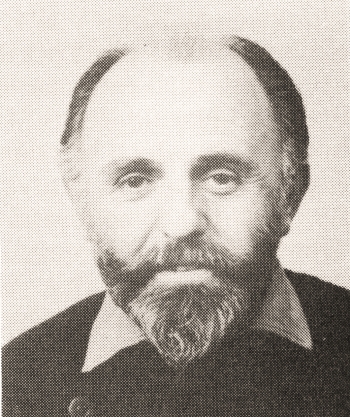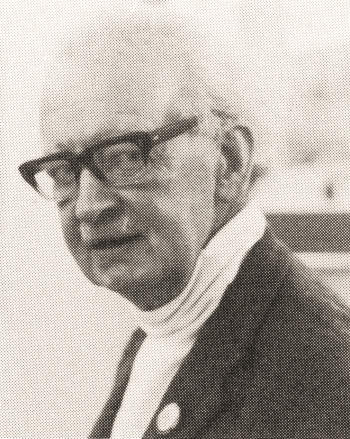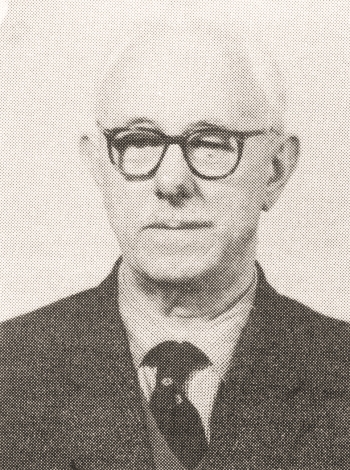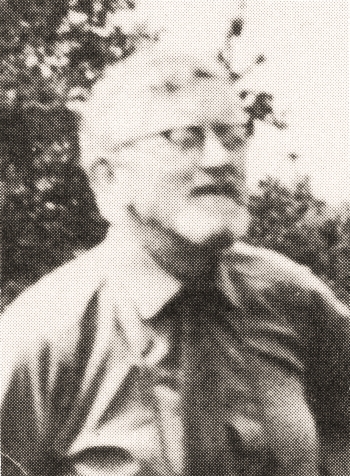In Memorandum
Joseph Lether
1952-1982
Joe joined the Club in 1952 and I can still remember first meeting him at a Meet at Lastingham soon afterwards. Passionately fond of walking, he was, for several years, Vice-President of the West Riding Branch of the Ramblers’ Association and was responsible for a great deal of the work done on footpath surveys during that time.
It was my good fortune to be invited to stay at his home after the Annual Dinner of the Club for more than 20 years. He was very keen on woodmaking and made a good deal of the furniture in his own home. Joe always selected the route and led the way over the Pennines on the After-Dinner Meet. He was a keen botanist and photographer which fitted in well with his love of hill-walking.
He was out walking in the Italian Alps near Bormio when he died. It was fitting he should be buried there amongst the mountains he loved so much. Our sympathies go to his widow Nancy, daughter Christine and grandchildren. For our part we miss the imperturbable Joe striding our hills and valleys, such a familar figure with his pipe and beret.
Horace Sutcliffe Stringer
1939-1982
Jim Stringer who died on the 13th September 1982 was a keen potholer in the early days of his membership, but never got back into the stream of Club activities after the war.
He had a busy law practice in South Yorkshire but maintained a lively interest in the proceedings of the Club.
John Arthur Dossor
1954-1983
With the death of Jack Dossor the Club has lost a most enthusiastic member and loyal supporter. Jack was born and lived all his life in Hornsea. He completed his dental training at Guy’s Hospital in 1939 and served in the Royal Army Dental Corps throughout the war. After a short association with a local practice he started his own surgery in Hull, where he practised until his retirement in 1983. He joined the Club in 1954 and his first day was typical of the many to follow. He had left Hornsea in the small hours of a January morning, driven to Low Hall Garth for breakfast and then ascended one of the gulleys on Great End in hard snow as one of a large party, and finishing his way back to the Club cottage by starlight. Jack was an habitual early riser and in the round-the-clock system that precluded all sleep in our early Skye Meets, Jack was always the motive force behind the shift which left at first light. His catering and cooking will always be remembered by the many who, at one time or another, were residents of ‘Grand Hotel’ at Whit. Meets and the term ‘Dossor Stew’ has been adopted locally as part of the English language.
Never changing from year to year, his tall lithe figure was always up with the first runners. Without fuss and always efficient he was a master craftsman with his hands, always able to make a neat repair in any emergency, and quietly knowledgeable on any subject which came up for discussion. Always under control, a leader by example, his self discipline was obvious. One recalls his uncomplaining wait for shearwaters to return to their burrows, sitting out the night in a polythene bag in an unexpected snow storm on the Cuillin Ridge of Rhum. These qualities were never more apparent when he endured a series of operations with outstanding fortitude.
He will be greatly missed by his many friends.
J. Denis Driscoll
1948-1983
It was a great shock to his many friends in the Club when they learned of the sudden death of Denis who collapsed and died at his home in Kentmere on the 19th December 1983. He was 69, and only a month earlier he had attended the Annual Dinner in Ilkley, when he was his usual cheery self, and had just attained 35 years Membership. He was born in Urmston, Manchester and before the war he was enaged in accountancy. During the war he served with the E.A.S.C. afterwards entering the teaching profession. He joined the Club in 1948 when living at Rainow in Cheshire from where he moved to the Lake District with his wife Margaret and opened a guest house in Kentmere. Over the years ‘The Grove’ gradually became a guest house of character and the many improvements and reconstructions were largely due to the Driscolls’ own efforts.
Denis devoted a lot of time and effort to the Club’s Low Hall Garth Hut in Little Langdale, becoming Hut Secretary in 1959 and Hut Warden from 1959 to 1963. He was Vice-President from 1968 to 1970.
The Christmas Meet at The Grove became a tradition with the Club Meet there every other year and it is a mystery how Margaret catered for so many members over the week¬end. The head of Kentmere was invariably littered with cars.
For over 25 years the New Year Meet at L.H.G. was communally catered for by Denis and Margaret, and Denis had only just been prevailed upon to record his reminiscences in the forthcoming Journal of the Club with the many amusing incidents which happened on the New Year Meets and of the often desperate struggles even to reach the Hut with snow and ice blocking the lane from the Colwith turn to Low Hall Garth.
Denis will be greatly missed and the Club suffered a great loss and our deepest sympathy goes out to Margaret in this so sad a bereavement.
Harold Singleton Booth
1924-1982
With the death of Harold Booth in 1982 one of the very few links with the early days of the Club was severed, for his father, Tom, became a member in the year of its formation, and up to 1982 there has always been a family member in the Y.R.C. – Harold was the last in the line.
He joined the Club in 1924, served on the Committee 1929/30, was Acting Librarian during the War Years and Librarian 1946/48. With his brother Fred he began climbing on Almscliff and was one of that select band including Frankland, Hilton and W.V. Brown that walked regularly to the Crag on Sundays from the Leeds tram terminus, climbed all day and then walked back – 20 miles plus the climbing. For over 20 years he was very active. Holidays invariably spent climbing, Skye, the Cairngorms (sleeping at the Shelter Stone), the Pyrenees and, of course, the Alps -always climbing without guides. He preferred climbing to potholing but he took part in the Rowten Pot rescue in 1939. My brother and I were fortunate to meet Harold and his brother Fred on our first Club Meet and there were few week-ends when we were not climbing or walking with them. Fred was the extrovert, Harold rather shy and retiring but nevertheless a splendid companion, always reliable on the not infrequent occasions we got into difficulties.
I remember vividly a day in 1935 on the Aiguille de la Tsa when Harold, Fred, my brother Frank, David Reed and I was trying to climb it by the South face. We were inexperienced then on Alpine Peaks and far too slow and had to retreat below the summit. During the descent a large boulder slid on to Fred’s ankle and damaged it. It was a long job getting him down in the darkness we were out 23 hours and Harold was a tower of strength – untiring, cool and never rattled.
Our sympathy goes to his family.
Edward Mallinson Tregoning
1957-1980
Edward was a Yorkshireman, born in Oxenholme on 11th September 1909, an d died on the 26th July 1980; he was the son of the Reverend Henry, a Wesleyan Methodist, and Agnes Tregoning, a member of a well known Colne Valley manufacturing family. He never married and his only sister, Mary, predeceased him in 1979.
In his early days the family lived in various parts of North East Yorkshire, moving from time to time in response to the demands of his father’s calling. During that time holidays were spent at Seascale, splendid occasions, the family travelling in an early model’T’ Ford motor car. It was from Seascale that Edward, then six years old, was taken by his father to the top of Helvellyn in a great gale and he never forgot the fierce wind at the summit nor the bliss of eating Sarah Nelson’s gingerbread in the summit shelter. His first summit, but a stimulus to wandering the hills ever since.
After school at the Leys, he took a Law Degree at Jesus College, Cambridge, followed by his articles in York and in 1935 he joined a firm of solicitors in Brighouse, retiring as senior partner in the late 1970’s.
In the late 1930’s he joined the Territorials and served during the war with the 49th. Searchlight Regiment A. A., in Belgium and Germany, with the rank of Major.
He was a keen philatelist and after coming to Brighouse he developed an interest in Scouting, becoming Chairman of the Local Association and District Commissioner for Rover Scouts. Although the Law was his life and work, the hills and nature were his love and his holidays were spent in the Alps for over 30 years until late in the 1970’s. He had a lovely garden with many roses and rock plants and a splendid collection of rhododendrons. His varieties of geraniums were very much admired and his friends were delighted to receive his many generous gifts. Edward had a lifelong interest in birds and an extensive knowledge of the calls and songs of passerines.
After his election to membership of the Club in 1957 he quickly became part of it, taking an increasing share in Club affairs and was elected to the Presidency in 1968-1970. He enjoyed the good things in life and was a splendid companion on the hills with a good feel for the country and a fine sense of direction in bad conditions.
Edward had a natural courtesy; was warm, generous and tolerant and as his friends well remember he invariably observed the precept “and whosoever shall compel thee to go a mile, go with him twain”. Edward was a gentle, kind man and a rare friend.
Edgar John Woodman
1927-1982
Jack Woodman died at his home in Kents Bank, Grange-over-Sands, aged 78, after a long illness. He was born in Otley and educated in Scotland and at Edinburgh University. He joined the family business of Kellett Woodman & Co. Ltd., Textile Manufactures of Bradford and eventually became the company’s chairman. After a severe illness when he was 28 he was advised to move into the country, but after farming for some years at Coniston, his health again deteriorated and he retired to Kents Bank.
Always fond of the countryside, Jack was a great walker and joined in many of the earlier potholing expeditions and in the famous early G.G. Meets. He was passionately fond of sailing and spent much of his time cruising up the West coast of Scotland, accompanied on-niany occasions by members of the Club. Up to the time of his death he regularly attended Club Meets and he will be sadly missed by his many friends.
John Hilton
1922-1981
Jack was born in Hull, the eldest of five children, on the 30th August 1890, and died on the 31st December 1981. After attending Hull Grammar School he came to Leeds at the age of 15 to be apprenticed to Dixon’s woollen mill and stayed there for 60 years. He married in 1926 and is survived by his only son, John to whom we express our sympathy. Jack enlisted for military service in 1915 and served throughout World War 1 with the Royal Horse and the Royal Field Artillery.
A fine athlete, his first love was rugger, and he captained Headingley and Yorkshire in the early 20’s. He was an excellent forward, full of fire, always on the ball and he kept his feet going, although it was asserted he did more damage with his elbows than many forwards did with their feet. He maintained his interest in the game all his life and a visit to Kirkstall with him quickly demonstrated that although a hard man himself he detested foul play.
Elected to the Y.R.C. in 1922 he soon took an active interest in the work of Club, being on the Committee from 1923-34 and a Vice-President in 1935/37. Jack was President in 1952-1954, and elected to Honorary Membership in 1965, an honour he greatly appreciated as he was heart and soul with the Club and all its affairs. From the start he climbed with Frankland who had proposed him for membership and for whom he had an enormous admiration. They were particularly impressive on Almscliff certainly in the eyes of one beholder as they climbed routes which were hazardous and severe. The account of their splendid climb on Esk Buttress in Journal No. 17 is delightful, the reader can almost feel he is there. Jack climbed in this country all his life and in the Alps with first class climbers. At about 70 years of age leading a loose and highly dangerous ‘garden’ area up the West end of Suilven, according to one of the party he ‘wormed his way up on his waistcoat buttons’. On his 80th birthday, Jack climbed Route 1 on Scout Crag and this was followed by Jack’s Rake and Gwynne’s Chimney. (Route 1 was first climbed in 1922, the year Jack joined the Club and Gwynne’s in 1892!) and when 90 he climbed route 2 on Scout Crag. He was a very strong climber who exuded confidence and seemingly unflappable.
As a hard potholer, he was with the ‘second wave’ in the early parties in Gaping Gill, Diccan Pot, Gingling Hole, Mere Gill, Rift Pot and many others. When about 77 he was in Mud Hall in Gaping Gill when the Club celebrated its 75th anniversary and this was probably his last pot. A fast climber in a long ladder and a stylist too, he scarcely moved the ladder as he climbed. Of the highest integrity and uncompromising in his standards he was naturally quiet and unassuming. Jack always encouraged younger companions who were never made aware of any generation gap. He will be sadly missed by his very many friends in the Yorkshire Ramblers’ Club.
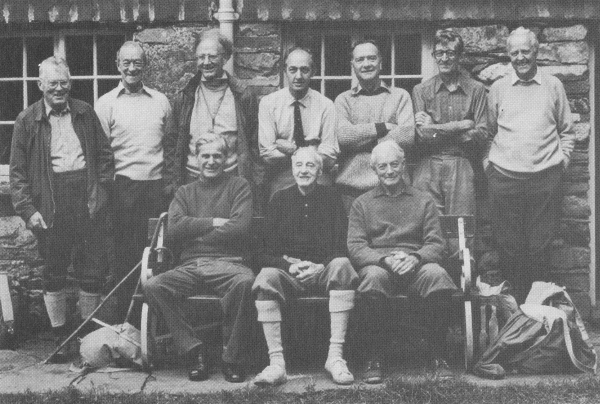
Back Row l to r. John Godley 1958-60, Frank Stembridge 1960-62, Bob Chadwick 1962-64, David Smith 1976-78, Jack Devenport 1974-76, Brian Nicholson 1972-74, Stanley Marsden 1956-58.
Front Row John Barton 1978-80, Jack Hilton 1952-54, Harry Stembridge 1954-56.
Alfred Butterfield
1928-1980
Alfred Butterfield died on the 3rd December 1980 at the age of 71 after 51 years membership of the Club. In his early days his main outdoor interests were walking and potholing and in the early 1930’s concentrated his activites in the exploration of Goyden Pot. In 1930 he made the low crawl at the entrance to Carbide Tin Passage and in 1931 despite being flooded out on at least four occasions he helped in the patient work which produced the valuable plan of Goyden (Y.R.C. Journal Vol.6. Page 228). Despite a long absence from the activities of the Club he maintained a warm loyalty to the Club and a lively interest in the exploits of Members.
Eric Hanson Sale
1928-1985
Eric Hanson Sale – “Rummy” to all his friends joined the Club in 1928 as one of the early members of what became known as the Teeside Group, a substantial number of members in the early thirties. Rummy was an enthusiastic member who attended many Meets both for potholing and climbing. As one of his close friends I can look back on very many happy days climbing under his leadership in the Lakes, Wales and above all in Skye. He was always cheerful in bad conditions and considerate of weaker bretheren.
His sporting activities also included playing hockey at County level and a not inconsiderable agility at golf and tennis.
After the war his Club activities were restricted by the demands of a growing family and the seductions of the golf course, but he continued to attend the Annual Dinner where his cheerful countenance will be missed.
David Stephenson Blair
1946-1982
David Blair was brought up in Harrogate, worked in Leeds and was active on the hills before the war. He was in the Territorial Army and served throughout the war. On returning to Leeds after the war he joined the Y.R.C. and was a very active Member until moving to London in 1949. David represented the Club on the B.M.C. for many years and still found time after his move to attend occasional Annual Dinners and Meets, especially in recent years when he began to make use of Club Huts with his son. He was a solicitor by profession and worked in the Department of the Solicitor to the Inland Revenue from 1949 until early 1982.
He will be missed by his many friends.
John Gott
1967-1983
The 13th August 1983 was a bright and hot summer day. John left the L.H.G. car park walking up Greenburn with his wife and daughter. After a swim in the tarn he left his family for a quick solo ascent of Wetherlam and during the return he slipped and fell and was killed instantly.
John was born in Nelson in 1930 and attended Nelson Grammar School before reading botany at Nottingham University. Both his parents were teachers and John followed the same profession; the whole of his career was spent in Yorkshire Schools.
The outdoor life always had its attraction for him, walking in the Lakes with his father. He enjoyed camping and was a proficient rock climber. His most notable achievement in this field was the first ascent of the Central Route on Sron na Ciche in the Cuillin in 1951. Perhaps the long and strenuous epic days in the Scottish Mountains were John’s forte and very few of his contemporaries in the Club would consider themselves his equal.
John joined the Club in 1967 and quickly established himself as a popular and well respected member. He served on the Committee from 1970 to 1975, he will be sadly missed by his many friends in the Y.R.C.
E.F. Higgins
1931-1979
Bill Higgins died in hospital at Holywell in North Wales on the 3rd December 1979 at the age of 78. He was a Doctor of Science in Metallurgy and became a Member of the Y.R.C. in 1931. He was an enthusiastic member of the Club in its caving and potholing activities in association with Ernest Roberts, Hal Yates and other veterans of the pre-war era and was a very helpful member of the team which made the first complete (at the time) survey, under the leadership of Hal Yates, of the intricate Goyden Pot system in Nidderdale.
His friendliness and great sense of humour made him a welcome member of many underground expeditions and I can see him now laughing at some joke as he smoked his rather unusual Austrian pipe.
He was very fond of animals and before he died was looking after at least six cats. I shall never forget going with him for a walk when Goyden Pot was flooded and seeing him dismantle as many rabbit traps as he could find.
Richard Brotherton Wharldall DSM. FRGS
1950-1983
Wally Whardall joined the Club in 1950 and died on Monday 19th December 1983, after a long and difficult illness which prevented him taking an active part in the Club activities during the later part of his life. He served on the Committee in 1955 to 1959 and was Assistant Editor from 1958 to 1959.
A Master Diver with a distinguished service career boundless energy and a desire to be involved with adventure in any form. Wally was a breeding ground for ideas and new projects, and though many of these failed to reach a satisfactory conclusion, it was unimportant. He will be remembered for enthusiasm, his continued support for the Club and its activities and his contribution to many organisations and charities throughout the country.
Hal Yates
1928-1979
Hal Yates died in hospital on the 27th August 1979 after a short illness having suffered a stroke. His ashes were scattered on the slopes of Pen-y-ghent. He was born in 1907 in Manchester and was educated at Fettes School in Edinburgh. He joined the family firm of seed merchants in Manchester and eventually became Chairman of the Board.
He was a man of individuality and character with a friendly philosophical attitued towards life and his love of nature in its various forms dominated his life in his leisure time. In the late 1920’s and the 1930’s he was an active Member of the Y.R.C. and took part in extensive explorations of the Yorkshire and Derbyshire potholes and caves with such enthusiasts as Ernest Roberts, W. V. Brown, Fred and Harold Booth, Harold Armstrong and others. His finest effort which he commenced in 1929 and took three to four years to complete was his very careful and accurate survey of the complicated Goyden Pot System in Nidderdale with its extensive labyrinth off the main river cave on more than one level. This effort with the help of Alfred Butterfield, Dr. W.F. Higgins and myself.
In those days we worked five and a half days in the week (Yates, Dr. Higgins and myself in the Manchester area) and it was Saturday evening when we arrived at Goyden Pot after yea at Butterfield’s in Bradford and fish and chips later in the village of Lofthouses. Alfred Butterfield knew the manager of Scar House Reservoir Higher up the dale and always ascertained that the sluice gates would not be opened and the cove system flooded before entering, which was usually about 10.30 p.m. emerging to our tents six hours later, after a good night’s work. A map of the survery with elevations, taken with aneroid barometer corrected to atmospheric pressure, ultimately appeared in the Y.R.C. Journal with an article by Hal Yates.
His sense of humour often took an unusual turn. When I first joined him on a caving expedition in 1929 he gave me a lesson on time and motion. There was no packing and carrying everything downstairs, all his gear went straight through his bedroom window on the second floor of his parents’ house into the garden to be loaded direct into the car. In those days we always carried tallow candles with us underground, these were a standby and were used quite often, acetylene and electric lights were not very reliable and it was said you could always eat them if you were trapped by flood water. Hal put them to further use. After some cave exploration a few of us went to a hotel, and Hal arrived a little late for dinner and casually remarked that he had lost his stud and had secured his collar with the wick of a tallow candle.
The last time I was underground was in “West Mine”, Alderley Edge in Cheshire in 1977. We descended a manhole in a field with the owner who wanted planning permission to open the mine to the public. We reached a main chamber down iron ladders where we observed some very interesting fungi.
Amongst Hal’s many accomplishments was his reputation as a water colour artist, and although strictly non professional he exhibited his paintings in a large number of galleries and exhibitions, including the Royal Academy and the Royal Institute of Painters where he was elected a member and held several offices. Many private and public galleries have his paintings in their permanent collections. The Y.R.C. of course has an excellent record of his characteristic tail pieces which appeared in the Journals and are much appreciated by members. In his latter years he was interested in nature conservancy and spent many hours patiently logging the occurrence of wild plants on local Cheshire roadsides and in hedgerows.
He joined the Y.R.C. just as it was leaving the last remains of its Edwardian foundation. In his early years Club Meets were always invariably held in substantial A.A. Hotels, and some of the older members’ activities were restricted to a game of bridge, followed by a church parade on Sunday mornings. By the end of Hal’s first decade of membership, the use of tents and barns for sleeping had grown enormously and the Club had been taken to the threshold of its present state of activity.
Geoffrey S. Gowing
1928-1984
Older members were saddened to learn of the death of Geoffrey Gowing, a member since 1928. Geoffrey joined the staff of a chemical Company at Billingham-on-Tees in 1924, and in a few years that Company became a part of I.C.I. There he met B.R. Goodfellow (known as Robin by all on Teeside) and in the summer of 1925 he introduced Geoffrey to rock climbing with a week-end in the Lakes. I went to Billingham in the autumn of 1925 and was also recruited by Robin for scrambling on various crags around Teeside and in the Lakes. By 1926 Geoffrey and I were climbing together fairly frequently in the Lakes and occasionally in Wales. At this time a party of former Armstrong College men (two of them working in Billingham) were exploring a cave on Leek Fell, viz. “Lost John’s”, and asked us to help. Thus Geoffrey and I were in the first party to descend Battleaxe Pitch and explore what we called the Main Drain below. It was our first experience of potholing. Some time afterwards the news reached Dr. A. Rule (President 1934-36) who, by then, was also working at Billingham, and he pressed us to visit the Y.R.C. Meet at Gaping Gill in 1928. This we did and became members of the Y.R.C. soon afterwards and in the next few years introduced many of our friends into the Club. Except for an interruption due to a tour of duty for I.C.I, in South Africa, Geoffrey continued to be a very active member of the Club for many years, serving twice on the Committee and as Assistant Editor 1938-1947 and Vice President 1948-49.
Corrie Cecil Gaunt
1957-1977
For many years Corrie Gaunt’s spare time was spent in conserving the countryside for ramblers and fell walkers. West Yorkshire members can be grateful for his persistent battle with Harrogate Borough Council for the preservation of rights of way through Haverah Park, including Almscliff, the Council’s water gathering area. He spent many hours obtaining information from local people and persuading them to attend a tribunal where the Inspector recommended against the Council. There were many other rights of way in the West Riding of which he was responsible for saving, and having sign-posted by the Local Authority. The public recognition of his work came when he was asked to become a Member of the Council for the Preservation of Rural England.
Similarly, after his retirement in 1967 to Silverdale, his hard work ensured increased public access to Arnside.Knott, Eaves Wood and Leighton Moss Bird Reserve.
Corrie Gaunt was not one of those in search of hard climbs and mountain tops. His ‘Everest’ was that of conserving wild life and the countryside for the benefit of later generations.
He was 82 years old when he died at Skipton on the 28th April 1984.
